| Odd Couples of the Animal Kingdom |
| Written by Jonathan C. Wojcik - Photo credits unknown or from public news articles unless otherwise noted. If you know their sources and need them credited or removed, please e-mail me. |
When we utilize dogs as hunting partners, horses to carry us faster and cats to control
mice, we're demonstrating mutualism, a situation in which two very different species
strike up a partnership that benefits both parties. We may demonstrate this more
frequently than any other creature on the planet, but as is so often the case, the rest of
nature is loaded with ever stranger, more extreme examples. Like a pitch for some
peculiar children's cartoon, one can find tiny frogs shacking up with enormous spiders,
carnivorous worms protecting vegetarian snails, fish and crawdads living together,
mass hysteria!
mice, we're demonstrating mutualism, a situation in which two very different species
strike up a partnership that benefits both parties. We may demonstrate this more
frequently than any other creature on the planet, but as is so often the case, the rest of
nature is loaded with ever stranger, more extreme examples. Like a pitch for some
peculiar children's cartoon, one can find tiny frogs shacking up with enormous spiders,
carnivorous worms protecting vegetarian snails, fish and crawdads living together,
mass hysteria!
| The Spider and the Frog |
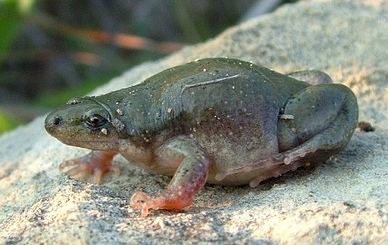
Life is tough when for the tiniest toad on the block. Adapted to prey exclusively on ants,
this narrow-mouthed toad is nothing but a hopping, croaking candy bar to whatever
scorpions, centipedes, lizards, snakes, birds, rats, other toads and sufficiently large
spiders can catch it off guard. Sufficiently large spiders besides one, that is!
this narrow-mouthed toad is nothing but a hopping, croaking candy bar to whatever
scorpions, centipedes, lizards, snakes, birds, rats, other toads and sufficiently large
spiders can catch it off guard. Sufficiently large spiders besides one, that is!

Like all tarantulas, the Oklahoma brown is an opportunistic predator that will plunge its
venomous fangs into even larger creatures for a bite to eat, and between this painful
venom, tough exoskeleton and irritating hairs, not many animals are willing to bite back.
Unfortunately, these defenses are all but worthless against the innumerable stingers
and jaws of the tiniest ants, who will boldly swarm over the eight-legged behemoths
and attack every chink in their armor. Here is where our froggy steps in. While any
other amphibian would make a prized morsel for these hefty arachnids, the
narrow-mouth toad apparently comes and goes from tarantula burrows waving a little
VIP pass that says "ant patrol." The frogs will even protect the spider's eggs and young
from ant predation, and can raise their own offspring in the spider's den with an eight
legged, acid-fanged nanny on guard duty. It's just like that show Muppet Babies, only
really not at all when you think about it.
venomous fangs into even larger creatures for a bite to eat, and between this painful
venom, tough exoskeleton and irritating hairs, not many animals are willing to bite back.
Unfortunately, these defenses are all but worthless against the innumerable stingers
and jaws of the tiniest ants, who will boldly swarm over the eight-legged behemoths
and attack every chink in their armor. Here is where our froggy steps in. While any
other amphibian would make a prized morsel for these hefty arachnids, the
narrow-mouth toad apparently comes and goes from tarantula burrows waving a little
VIP pass that says "ant patrol." The frogs will even protect the spider's eggs and young
from ant predation, and can raise their own offspring in the spider's den with an eight
legged, acid-fanged nanny on guard duty. It's just like that show Muppet Babies, only
really not at all when you think about it.
| The Ants and the Ant-cows |
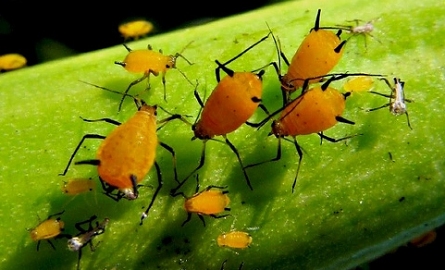
A feared plague any gardener knows all too well, aphids or "plant lice" are
veggie-sucking bugs whose only natural defense are their sheer numbers. Literally
born pregnant, they do virtually nothing but eat, multiply and defecate. Lucky for them, at
least one of those things is more precious than their meat...
veggie-sucking bugs whose only natural defense are their sheer numbers. Literally
born pregnant, they do virtually nothing but eat, multiply and defecate. Lucky for them, at
least one of those things is more precious than their meat...
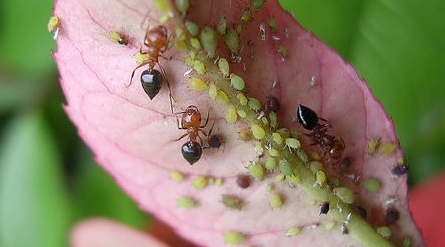
Many, many species of ant are known to feast upon their sugary, sticky excrement of
aphids, more appetizingly known as "honeydew," and will fiercely protect their aphid
"herds" from marauding predators, even gently carrying aphids in their jaws during
emergency situations. These little farmers have even adapted a special signal to "milk"
their aphids, or more bluntly, a special way of stroking an aphid's bottom that says
"crap in my mouth!"
aphids, more appetizingly known as "honeydew," and will fiercely protect their aphid
"herds" from marauding predators, even gently carrying aphids in their jaws during
emergency situations. These little farmers have even adapted a special signal to "milk"
their aphids, or more bluntly, a special way of stroking an aphid's bottom that says
"crap in my mouth!"
| The Potter's Wasp and the Mites |
The various species of potter's wasp are known throughout the world for the delicate,
beautiful little nests they construct from dried mud. Each nest contains a supply of
paralyzed prey, usually caterpillars, upon which the wasp will lay a single egg, ensuring
its larva has a massive supply of food. Unfortunately, mother's pottery isn't always
enough to keep the little wasplet safe, especially from much tinier parasitoid wasps. If
only there was some sort of bug babysitting service...
beautiful little nests they construct from dried mud. Each nest contains a supply of
paralyzed prey, usually caterpillars, upon which the wasp will lay a single egg, ensuring
its larva has a massive supply of food. Unfortunately, mother's pottery isn't always
enough to keep the little wasplet safe, especially from much tinier parasitoid wasps. If
only there was some sort of bug babysitting service...
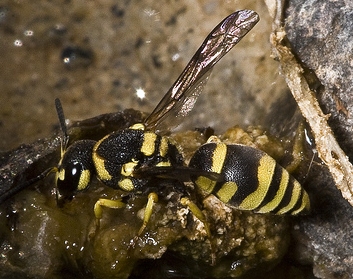
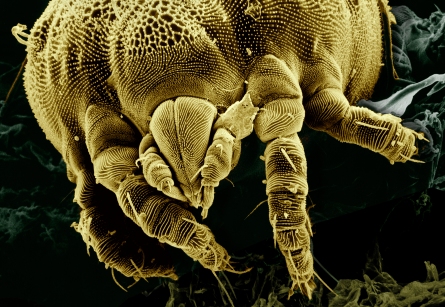
...like wasp-friendly mites, for instance. This isn't a photo of the species I'm talking
about here, but it's plenty close enough. The actual mites in question live in special
pockets on the back of a female wasp, waiting for their chance to colonize the wasp's
egg chamber and share the larva's stockpile of prey. At one time, these mites were
believed to be parasites, until it was discovered that they gang up and fiercely attack
any other little creatures that may invade the chamber and threaten the developing
wasp. If the young wasp turns out to be female, the mites will have a fresh new "crew"
ready to board the stinging, buzzing vessel.
about here, but it's plenty close enough. The actual mites in question live in special
pockets on the back of a female wasp, waiting for their chance to colonize the wasp's
egg chamber and share the larva's stockpile of prey. At one time, these mites were
believed to be parasites, until it was discovered that they gang up and fiercely attack
any other little creatures that may invade the chamber and threaten the developing
wasp. If the young wasp turns out to be female, the mites will have a fresh new "crew"
ready to board the stinging, buzzing vessel.
| The Goby and the Shrimp |
Gobies are a fairly large, adorably named group of bottom-loving fish, often
recognizable by their bulging, frog-like eyeballs. Most rely entirely on reflexes and
camouflage to evade their many predators, but some species buddy up with a clawed
sea-bug for a little extra security.
recognizable by their bulging, frog-like eyeballs. Most rely entirely on reflexes and
camouflage to evade their many predators, but some species buddy up with a clawed
sea-bug for a little extra security.

The many species of shrimp Goby all live their lives alongside different species of
burrowing, half-blind shrimp. While the crustacean constructs and maintains a
reinforced, well-hidden tunnel, the fish hangs out at the entrance and uses its keen
vision to keep watch for larger animals who would love a two-for-one seafood special.
The shrimp will use its long feelers to keep in nearly constant contact with its
seeing-eye fish, who signals approaching danger with a flick of its tail. The crustaceans
will even take the time to build a nest for gobies many times their own size, and will use
their claws to keep their fishy-friends well groomed.
burrowing, half-blind shrimp. While the crustacean constructs and maintains a
reinforced, well-hidden tunnel, the fish hangs out at the entrance and uses its keen
vision to keep watch for larger animals who would love a two-for-one seafood special.
The shrimp will use its long feelers to keep in nearly constant contact with its
seeing-eye fish, who signals approaching danger with a flick of its tail. The crustaceans
will even take the time to build a nest for gobies many times their own size, and will use
their claws to keep their fishy-friends well groomed.

| The Bell Lerps and the Bell Miner |
Similar to aphids but even more helpless, bell lerps are tiny, barely-mobile Australian
insects that encrust all over plant life like a bunch of soft little barnacles, "protected"
only by a waxy dome or "bell" of bug feces consisting almost entirely of sugar. They're
practically nature's M&M's, and these squishy bugs with candy shells would be sitting
ducks if not for winged protectors hundreds of times their size - the BELL MINERS.
insects that encrust all over plant life like a bunch of soft little barnacles, "protected"
only by a waxy dome or "bell" of bug feces consisting almost entirely of sugar. They're
practically nature's M&M's, and these squishy bugs with candy shells would be sitting
ducks if not for winged protectors hundreds of times their size - the BELL MINERS.
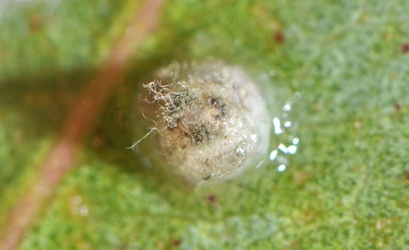
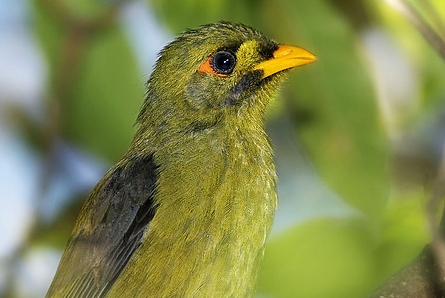
While many animals would love a crunchy, gooey bug & feces sandwich, these cute
little songbirds have learned, much like aphid-farming ants, that when you leave the bug
behind, the sweet, sweet coating will eventually come back. Almost their entire diet
consists of the lerp's mouth-watering crap-hats, and should any other creature move in
on their livestock, these little guardian angels will swoop in on the assailants to
administer a sound pecking. Bell Miners even protect lerp colonies to such an extent
that the insects begin to cause serious damage to host trees, making the birds a sort
of "accomplice pest"....but go ahead, look into those little green faces and tell them
they're pests. I dare you.
little songbirds have learned, much like aphid-farming ants, that when you leave the bug
behind, the sweet, sweet coating will eventually come back. Almost their entire diet
consists of the lerp's mouth-watering crap-hats, and should any other creature move in
on their livestock, these little guardian angels will swoop in on the assailants to
administer a sound pecking. Bell Miners even protect lerp colonies to such an extent
that the insects begin to cause serious damage to host trees, making the birds a sort
of "accomplice pest"....but go ahead, look into those little green faces and tell them
they're pests. I dare you.